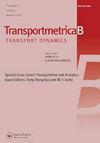混合交通环境下连通车辆和自动车辆的变道耦合过程策略
IF 3.4
2区 工程技术
Q2 TRANSPORTATION
引用次数: 2
摘要
本文章由计算机程序翻译,如有差异,请以英文原文为准。
Strategy of lane-changing coupling process for connected and automated vehicles in mixed traffic environment
Heterogeneous traffic agents consisting of human-driven vehicle (HDV) and connected-automated vehicle (CAV) appear on the road and form a mixed traffic environment. When combining the characteristics of CAVs and HDVs, it's still an open issue of investigating how heterogeneous traffic agents will execute lane-changing. With respect to the coupling process in the lane-changing behaviour of vehicles, this paper derives the lane changing optimization method for CAVs under different penetration rates. This method captures not only the full spectrum of CAV penetration rates but also all types of vehicle platoon. Firstly, the different car-following and lane-changing models are used to capture the characteristics of different types of vehicles. Moreover, For CAV, the Cooperative Adaptive Cruise Control (CACC) vehicle would degrade into the Adaptive Cruise Control (ACC) vehicle due to communication failure. Secondly, the framework for the coupling analysis of CAV lane-changing behaviour and mixed traffic stability is derived. Then, this study proposes and examines optimal control strategies based on numerical simulation. These consist of a longitudinal phase, in which the proposed strategies improve the operational efficiency of the overall mixed traffic flow, and a lateral phase, in which they safely change lanes. The results show that they improve the comfort, efficiency, safety, and stability of the heterogeneous traffic agents compared to the maneuvers performed by the baseline. This method can serve as a useful and simple decision tool for future CAV lane management.
求助全文
通过发布文献求助,成功后即可免费获取论文全文。
去求助
来源期刊

Transportmetrica B-Transport Dynamics
TRANSPORTATION SCIENCE & TECHNOLOGY-
CiteScore
5.00
自引率
21.40%
发文量
53
期刊介绍:
Transportmetrica B is an international journal that aims to bring together contributions of advanced research in understanding and practical experience in handling the dynamic aspects of transport systems and behavior, and hence the sub-title is set as “Transport Dynamics”.
Transport dynamics can be considered from various scales and scopes ranging from dynamics in traffic flow, travel behavior (e.g. learning process), logistics, transport policy, to traffic control. Thus, the journal welcomes research papers that address transport dynamics from a broad perspective, ranging from theoretical studies to empirical analysis of transport systems or behavior based on actual data.
The scope of Transportmetrica B includes, but is not limited to, the following: dynamic traffic assignment, dynamic transit assignment, dynamic activity-based modeling, applications of system dynamics in transport planning, logistics planning and optimization, traffic flow analysis, dynamic programming in transport modeling and optimization, traffic control, land-use and transport dynamics, day-to-day learning process (model and behavioral studies), time-series analysis of transport data and demand, traffic emission modeling, time-dependent transport policy analysis, transportation network reliability and vulnerability, simulation of traffic system and travel behavior, longitudinal analysis of traveler behavior, etc.
 求助内容:
求助内容: 应助结果提醒方式:
应助结果提醒方式:


